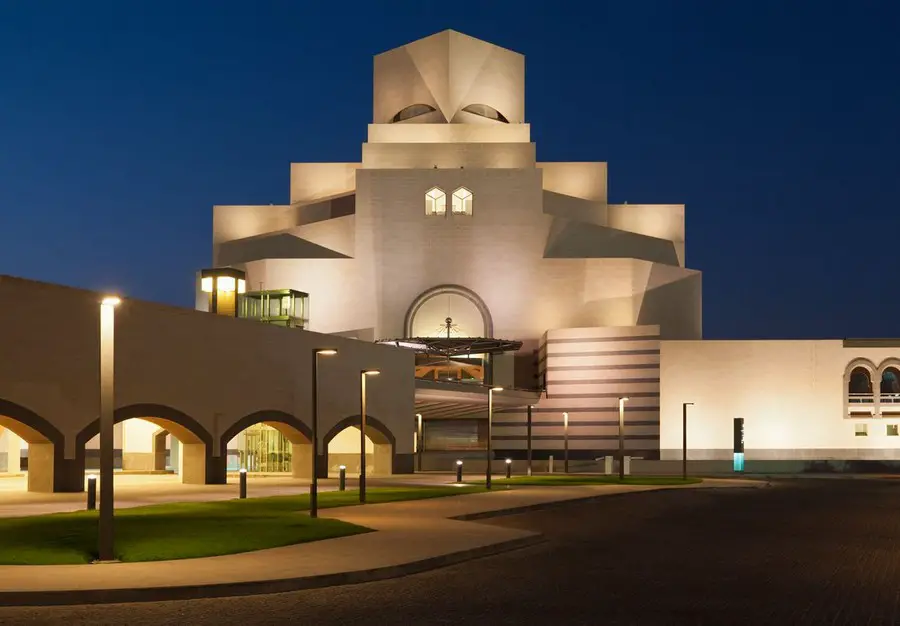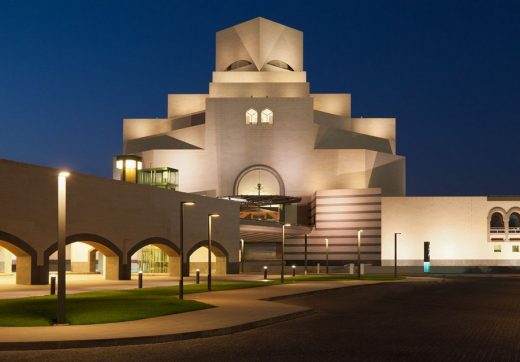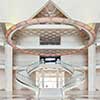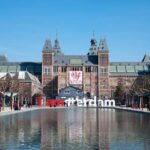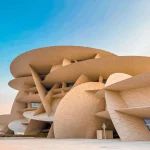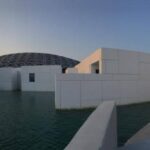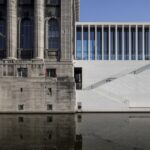Museum of Islamic Art, Qatar Architecture, Modern Doha Building, Architect, MIA Project
Museum of Islamic Art Doha : Qatar Architecture
Key Cultural Development in The Gulf, Middle East design by I M Pei Architect
8 Dec 2008
Location: Doha, Qatar
Date built: 2008
Design: I M Pei
The Museum of Islamic Art appears to float above the waters of the Arabian Gulf:
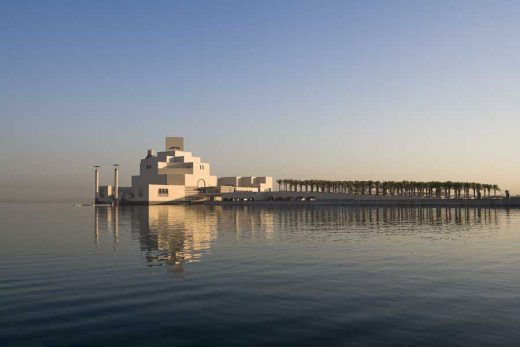
Courtesy of the Museum of Islamic Art
Museum of Islamic Art
MUSEUM OF ISLAMIC ART OPENS IN QATAR IN ICONIC I.M. PEI-DESIGNED LANDMARK BUILDING
Inaugural Exhibition Celebrates Cultural Diversity and Complexity of Islamic Art Doha
The Museum of Islamic Art’s main building entrance façade through the palm tree alley:
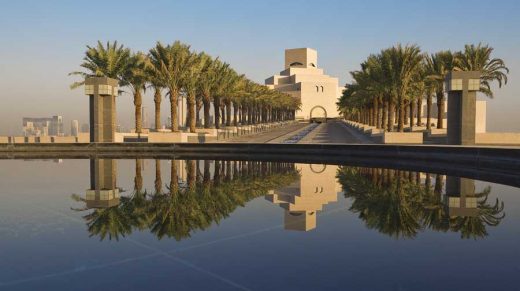
Courtesy of the Museum of Islamic Art
The Museum of Islamic Art, a new cultural icon for the Gulf region, opened its doors to the public on December 1, 2008. Dedicated to reflecting the full vitality, complexity and diversity of the arts of the Islamic world, the Museum of Islamic Art will collect, preserve, study and exhibit masterpieces spanning three continents from the 7th to the 19th century. Under the leadership of Her Excellency Sheikha Al Mayassa bint Hamad bin Khalifa Al-Thani, Chairperson of the Qatar Museums Authority’s Board of Trustees, the Museum of Islamic Art will be a new international centre for learning and creativity that advances the cultural vision of the State of Qatar.
The Museum of Islamic Art will be officially inaugurated later today by His Highness the Emir, Sheikh Hamad Bin Khalifa Al-Thani, in an opening celebration attended by Heads of State, dignitaries and museum leadership from around the world. Highlights of the grand opening festivities will be a performance by The Silk Road Ensemble with renowned cellist Yo-Yo Ma.
View of the Museum of Islamic Art from the Doha Corniche:
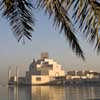
Courtesy of the Museum of Islamic Art
Designed by Pritzker Prize-winning architect I.M. Pei, the 376,740-square-foot Museum of Islamic Art rises from the sea, in Doha Bay in the Arabian Gulf and houses a collection of international masterpieces in galleries encircling a soaring, five-storey-high domed atrium. The inaugural installation of the permanent collection will showcase highlights ranging geographically over 7,000 miles from Spain to India and spanning more than 1,300 years. A special exhibition in partnership with leading cultural institutions will explore cross-cultural exchange across the Muslim world.
The Museum of Islamic Art against the Doha skyline:
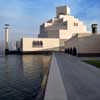
Courtesy of the Museum of Islamic Art
“The opening of the Museum of Islamic Art is a source of immense pride for the State of Qatar. In future years, the new museum will evolve into a place of learning and a platform for dialogue. It will bring together people of all ages, people living in the local community and visitors from around the world for enjoyment, stimulation and greater understanding of our cultures through the appreciation of art,” commented Museum of Islamic Art Chairperson, Her Excellency Sheikha Al Mayassa bint Hamad bin Khalifa Al-Thani.
Museum of Islamic Art, reflected in the waters of the Arabian Gulf:
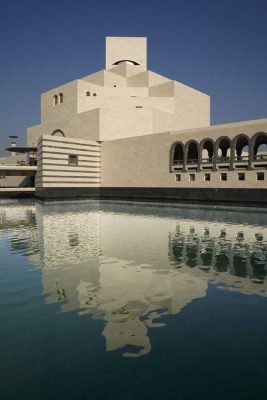
Courtesy of the Museum of Islamic Art
“With the opening of the Museum of Islamic Art, the state of Qatar has become an important contributor to the international art world,” said Abdulla Al Najjar, CEO of the Qatar Museums Authority. “We are proud to open the doors of this magnificent I.M Pei masterpiece, and to share with the world the exceptional depth and vitality of Islamic art.”
Museum of Islamic Art is located on its own island off the Doha Corniche:
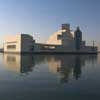
Courtesy of the Museum of Islamic Art
“We are thrilled to be able to display more than 800 pieces in the inaugural installation of our permanent collection, including many masterpieces of Islamic art that have rarely or never been exhibited before,” said Oliver Watson, director of the Museum of Islamic Art. “We also look forward to beginning a cultural dialogue with our partner institutions from around the world, exploring the influence of Islamic art in our first temporary exhibition, Beyond Boundaries: Islamic Art Across Cultures.”
Striking geometry of the Museum of Islamic Art viewed from the southwest:
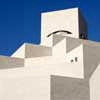
Courtesy of the Museum of Islamic Art
The Building
The Museum of Islamic Art is the result of a journey of discovery conducted by I.M. Pei, whose quest to understand the diversity of Islamic architecture led him on a world tour. During visits to the Grand Mosque in Cordoba, Spain; Fatehpur Sikri, a Mughal capital in India; the Umayyad Great Mosque in Damascus, Syria; and the ribat fortresses at Monastir and Sousse in Tunisia, he found that influences of climate and culture led to many interpretations of Islamic architecture, but none evoked the true essence he sought.
Museum of Islamic Art situated 60m off the Doha Corniche on an island made of reclaimed land:
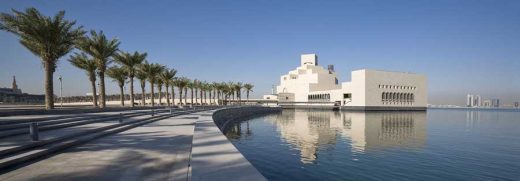
Courtesy of the Museum of Islamic Art
Mr. Pei’s final design inspiration was the 13th-century sabil (ablutions fountain) of the Mosque of Ahmad Ibn Tulun in Cairo, Egypt (9th century). In the “austerity and simplicity” of the sabil, Mr. Pei stated, he found “a severe architecture that comes to life in the sun, with its shadows and shades of colour.” The sabil offered “an almost Cubist expression of geometric progression,” which evoked an abstract vision of the key design elements of Islamic architecture.
The desert light plays with the geometry of the Museum of Islamic Art:
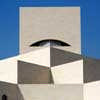
Courtesy of the Museum of Islamic Art
Declining to build the structure on any of the proposed sites along the Corniche, Mr. Pei suggested a stand-alone island be created to ensure future buildings would never encroach on the Museum. The building stands in the sea some 195 feet off Doha’s Corniche. A park of approximately 64 acres of dunes and oases on the shoreline behind the Museum offers shelter and a picturesque backdrop.
Built of fine materials, such as cream-coloured Magny and Chamesson limestone from France, Jet Mist granite from the United States and stainless steel from Germany, as well as architectural concrete from Qatar, the Museum is composed of a five-storey main building and a two-storey Education Wing, which are connected across a central courtyard. The main building’s angular volumes step back progressively as they rise around a 164-foot-high domed atrium, which is concealed from outside view by the walls of a central tower. At the top of the atrium, an oculus captures and reflects patterned light within the faceted dome. The desert sun plays a fundamental role, transforming the architecture into a play of light and shadows.
Angular structural supports of the Museum of Islamic Art complement the faceted dome above:
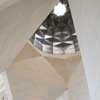
Courtesy of the Museum of Islamic Art
A glass curtain wall on the north side of the Museum offers panoramic views of the Gulf and West Bay area of Doha from all five floors of the atrium. Ceilings are embellished with intricate coffered domes, and perforated metal chandeliers hang in the atrium. Two more lanterns, each 100 feet tall, mark the boat dock on the west side of the Museum, creating a grand entrance for guests arriving by boat.
The galleries, designed by Jean-Michel Wilmotte from Paris, France feature dark grey porphyry stone and Louro Faya, a Brazilian lacewood that was brushed and treated to create a metallic appearance, which contrast with the light-coloured stonework of the rest of the Museum. To protect the fragile antiquities on display, the exhibition rooms feature specially designed cases and lighting. Mr. Wilmotte also created custom furniture for the museum, inspired by Pei’s architectural style.
The faceted dome of the Museum of Islamic Art features an oculus that captures and reflects sunlight:
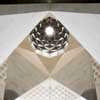
Courtesy of the Museum of Islamic Art
The Museum’s education programs are housed in a 29,000-square-foot wing, located to the east of the main building across a fountain courtyard. The Education Wing, scheduled to open late 2009, includes a light-filled reading room in the Museum library, classrooms, workshops, study spaces, and technical and storage facilities. Among the latter is the conservation laboratory, an important new resource for the entire region. Underscoring the central role of education in the Museum of Islamic Art, the Education Wing will host educational and community activities to develop and foster an understanding and appreciation for Islamic art.
The grand staircase at the Museum of Islamic Art, as seen from the main entrance:
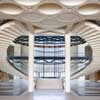
Courtesy of the Museum of Islamic Art
The Collection
Illustrating the diversity and creativity of Muslim culture, the Museum’s permanent display will showcase more than 800 works representing the full scope of Islamic art, including manuscripts, ceramics, metal, glass, ivory, textiles, wood and precious stones. Objects in the collection represent cultures on three continents, a huge geographical area reaching as far west as Cordoba and as far east as Samarqand, and encompasses works from Spain, North Africa, Egypt, Syria, Iraq, Turkey, Iran, India and Central Asia.
Among the highlights of the Museum¡¦s wide-ranging collection are:
– an Indian jade pendant (1631-1632), worn to cure a broken heart, that belonged to Shah Jahan, the bereaved widower who created the Taj Mahal in tribute to his beloved wife
– a 9th-century white earthenware bowl from Iraq, which illustrates the cross-cultural influences between Muslim and Chinese ceramicists, including the introduction of classic “blue and white. pottery
– a page from a colossal Central Asian Qur’an (c. 1400), which was created for the emperor Timur after a tiny version.so small as to fit within a signet ring.failed to impress the ruler
– a 15th-century Spanish silk curtain, featuring highly ornate, brightly coloured dense patterning and Arabic descriptions that evoke the decoration of the Alhambra palace in Granada
Gallery view of the “Writing in Art” section of the Museum of Islamic Art’s permanent collection:
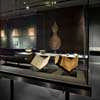
Photo : Lois Lammerhuber
The treasures from the collection will be exhibited on two floors of galleries that encircle the atrium of the Museum. Visitors will journey through time and across cultures and regions, as the galleries are dedicated to themes of historical periods and dynastic groups.
The Language of Islamic Art The first of these floors highlights the visual elements that are found universally in the arts of the Islamic world. Galleries feature the themes of Calligraphy, the Figure, Pattern and Science in Art.
Arabic calligraphy, or beautiful writing, represents the language of God and has a special significance in Islamic art. Calligraphy balances the rhythmic movement of letters with the perfection of form, and the words themselves can represent or invoke power, protection and blessing. As early as the 7th century, the written word became the distinctive symbol of Islam, used on buildings and coinage to represent the authority of the Muslim civilization. Among the collection highlights on display is one of the rarest and earliest versions of the Qur’an to survive. Dating from the 7th-early 8th century, perhaps written within decades of the death of the Prophet Muhammad, the pages are written in Hijazi script, developed near the cities of Mecca and Medina. Other important manuscripts are shown, as are works of art showing the use of calligraphy as a major element of design.
Gallery view of the Egypt and Syria (12th-13th Century) section of the Museum of Islamic Art’s permanent collection:
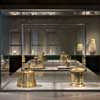
Photo : Lois Lammerhuber
Many believe that the figure is “banned” in the Islamic world. While the depiction of humans and animals is avoided in purely religious contexts such as mosques, tombs and the Qur’an, much of Islamic art is created for domestic or non-religious use where such depictions are common. Figures are used as illustrations in books, as symbolic or allegoric decorations, or as part of decorative schemes. On view in this section is a late 16th-early 17th century Iranian silk tapestry that features a narrative scene of the love story of “Laila and Majnun,” an Arabic tale often likened to “Romeo and Juliet”. Also shown are a remarkable set of tent panels in silk “cloth of gold”, dating to the 14th century, and a series of small-scale sculptures in pottery and metalwork.
A number of basic patterns are used in Islamic art. Geometric patterns are seen as a cornerstone of Islamic decoration, and are joined by floral motifs, the arabesque and other particular patterns to provide a rich and varied repertoire for Islamic artists. A mosaic tile panel (Iran, c. 1480) reflects a combination of Chinese and Islamic motifs, including chinoiserie lotus flowers, rosettes, foliage, arabesques and split palmettes set in a geometric framework.
Gallery view of the Early Islamic Art (7th-12th Century) section of the Museum of Islamic Art’s permanent collection:
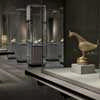
Photo : Lois Lammerhuber
Science in Art shows how scientists of the Muslim world made significant contributions to the fields of astronomy, mathematics, engineering and medicine. The precision instruments created as tools for the pursuit of knowledge and scientific thought are also beautiful works of art. The collection is of major importance, containing a wealth of signed and dated pieces by important makers, such as a Spanish brass astrolabe (1309-1310) that is one of only three surviving astrolabes made by Ahmed ibn Husain ibn Baso, a well-known astronomer and official time-keeper of the great mosque of Granada. Also on view is The Book of Fixed Stars by al-Sufi (Iraq, 1125), one of the earliest surviving illustrated scientific books and an important object in the history of both Islamic science and Islamic painting.
The Journey of Islamic Art The second of the Museum’s permanent collection floors offers a chronological exploration of Islamic art. These galleries feature works illustrating a wide diversity of styles, yet a unified aesthetic can be seen through the centuries.
Although the early Islamic empire gradually fragmented as independent dynasties took control, aesthetic principles of the early Islamic period (7th-10th century) continued to be instilled throughout the Islamic world. Highlights from this early period include a pair of Egyptian golden bracelets and a series of Córdoban marble capitals, which show the growth of luxury and decorative detailing.
Nomadic tribes from Central Asia transformed the Islamic world from the 12th -14th century, including the Seljuks, who took control of Iran, Iraq and Syria, and the Il-Khanids, who ruled Iran and Weastern Asia under the grandson of Mongol warlord Genghis Khan. Many works from this era show the influence of Chinese motifs, such as the lotus flower, phoenix and dragon. On view in these galleries are two 13th-century Central Asian silk and gold-thread robes that were worn by the highest ranks of Mongol society. The stucco head of a male figure (Iran, c. 1200) is a rare example of three-dimensional human representation in the Islamic world.
The fountain café on the ground floor of the Museum of Islamic Art:
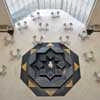
Courtesy of the Museum of Islamic Art
Damascus and Cairo were important centres of art production during the Ayyubid dynasty (1169-1260), creating refined lustre and underglaze-painted ceramics, glass decorated with enamel and gilding, and brass vessels inlaid with silver. A magnificent pair of cast brass door knockers (Syria, Jazira or Iraq, early 13th century) features an interlaced arabesque design, and an inlaid brass tray stand (Syria, 1240-1260) depicts symbols of power including an enthroned ruler, hunting scenes and astronomical images. The Museum’s collection of silver-inlaid metalwork is of paramount importance to the study of this art.
When the Mamluks took power in Cairo (1250-1517), glass production flourished, in particular intricately enamelled mosque lamps of which the Museum has a large and important collection. Many religious buildings at the time were given sets of Qur’ans featuring elegant calligraphy, illumination and fine leather bindings. A rare and unusually shaped round carpet (Egypt, c. 1575) features kaleidoscopic designs in red, green, blue and yellow, and is densely decorated with octagons, hexagons, triangles and stars.
The grand spiral staircase at the centre of the atrium of the Museum of Islamic Art is offset from the patterned chandelier:
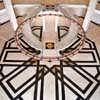
Courtesy of the Museum of Islamic Art
The Timurids conquered Central Asia, Iran, Iraq and parts of India and southern Russia from the 14th to 16th century. Known for their art patronage, the emperor Timur gathered artists and craftsmen from across the empire in Samarqand. The Timurid “International Style” included architecture characterized by its monumental size and extensive use of tilework, and the art of the book was also favoured. An unparalleled piece in the collection is a silk carpet, known as the “Timurid Chessboard Garden Carpet” (Iran or Central Asia, 14th to 15th centuries). The most unique and unusual element of the design is a chessboard image woven into the carpet, perhaps representing Timur’s fondness for the game.
An artistic renaissance in Iran under the Safavids and Qajars (16th-19th century) led to a flourishing period in manuscript illumination and the production of carpets and textiles. Here are seen a group of silk and wool carpets from the Museum’s collection which is recognised as one of the most important in the world.
The Museum of Islamic Art features a 5-storey window that offers views of the Gulf and the West Bay of Doha:
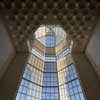
Courtesy of the Museum of Islamic Art
The Mughal Empire (16th-18th century) encompassed most of the Indian subcontinent including present-day Pakistan and Afghanistan. The arts of the Mughals, including jewellery, jade, textiles and the art of the book, reflect wide religious and cultural diversity, as well as an increasing European trade presence. A carved emerald (India, 1695-1697), inscribed with a Shi’a prayer, was worn as a talisman to ward off demons or prevent illness. A gold falcon encrusted with rubies, emeralds and other gems evokes the splendour of the Mughal court and demonstrates the extraordinary accomplishment of its artists.
The Ottoman imperial workshops in Istanbul from the 16th to the 18th century also created a distinctive style, as seen in illustrated manuscripts, calligraphy, carpets, textiles, ceramics and metalwork. A 16th-century imperial decree, bearing the tughra (or signature) of Sultan Suleiman the Magnificent, bestows the gift of a palace to his granddaughter. The elegance of the Ottoman chancery script, the substantial size of the scroll and the ample space given to just a few lines of text imbue the document with a majestic quality and transform a legal decree into a work of art. The armoured horse and rider that dominates the gallery reminds us of the military accomplishments of the Ottomans, who over centuries struck fear into the hearts of the Europeans.
View of the manuscripts/rare books reading room located in the Education Wing library:
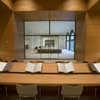
Courtesy of the Museum of Islamic Art
The Inaugural Temporary Exhibition
In celebration of the grand opening, the Museum of Islamic Art has organised a special inaugural exhibition that is the first of an ambitious program of international exhibitions and collaborations. On view December 1, 2008 – February 22, 2009, Beyond Boundaries: Islamic Art Across Cultures brings together leading cultural institutions from around the world, all of which have loaned artworks that reflect the theme of cultural diversity in the heritage of the Muslim world. These special loans will be juxtaposed with highlights from the Museum of Islamic Art’s collection.
Qatar Museums Authority
The Qatar Museums Authority was created in December 2005 to combine the resources of all museums in the State of Qatar. The Authority provides a comprehensive umbrella under which future plans will be drawn for the development of national museums and the establishment of an effective system for collecting, protecting, preserving, and interpreting historic sites, monuments, and artefacts.
Visitor Information
The Museum of Islamic Art, Al Corniche Doha, Qatar
Telephone: +974 422 4444 www.mia.org.qa
The Museum of Islamic Art is open Sat through Mon, Wed & Thu: 10:30 am – 5:30 pm, and Fri: 2:00 – 8:00 pm.
The museum is closed on Tue, December 25 and the first day of Eid.
There is no charge for admission to the museum or to the first Temporary Exhibition.
Interior of the Education Wing library designed by Jean-Michel Wilmotte & Associés:
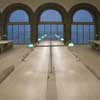
Courtesy of the Museum of Islamic Art
Museum of Islamic Art Qatar Images + Information received 081208
Museum of Islamic Art Doha architect : I M Pei
Location: Al Corniche, Doha, Qatar
New Architecture in Qatar
Contemporary Qatar Architecture
Qatar Architecture Designs – chronological list
Doha or Ad-Dawhah / Ad-Dohah is the capital city of Qatar
Museum of Islamic Art Education Wing library architects : Jean-Michel Wilmotte & Associés
Lusail Iconic Stadium
Foster + Partners
Lusail Iconic Stadium Qatar
Comments / photos for the Museum of Islamic Art Qatar Architecture design by I M Pei Architect page welcome

